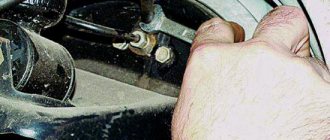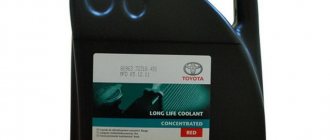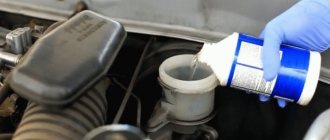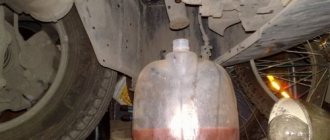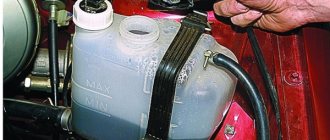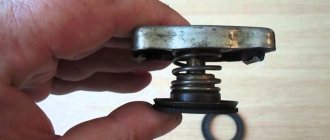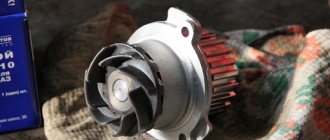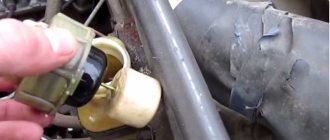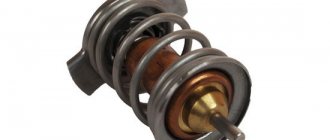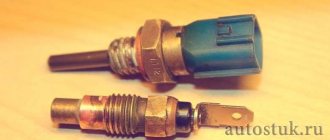Types of brake fluids and their characteristics
Currently, the most widely used brake fluids are classified according to the standard of the American Department of Transportation. Abbreviated as DOT.
According to this classification, today more than 95% of all vehicles use one of the following fluids:
Domestic liquids “Neva” (similar in composition to DOT-3, usually modified with additives that increase the freezing point), “Rosa” (analogue of DOT-4) and the like are becoming increasingly rare. The reason for this was the almost universal transition of Russian manufacturers to labeling according to the American standard.
Let us briefly consider the main characteristics and scope of application of the above brake fluids.
- DOT-3. Obsolete glycol fluid. It is used mainly in foreign cars older than 15-20 years and in VAZ classics. It has high hygroscopicity (the ability to accumulate water in volume). The boiling point of fresh liquid is approximately 205°C. After the accumulation of more than 3.5% water of the total volume of the liquid, the boiling point drops to approximately 140°C. It behaves quite aggressively towards certain plastics and rubbers.
- DOT-4. Used in relatively new cars. The base is polyglycol. Has greater resistance to moisture absorption from the environment. That is, it lasts a little longer (on average six months to a year). However, additives that reduce hygroscopicity and level out chemical aggression slightly thickened this liquid. At -40°C the viscosity is slightly higher than other DOT fluids. The boiling point of the “dry” liquid is 230°C. Moisture (more than 3.5%) reduces the boiling point to 155°C.
- DOT-5. Silicone liquid. Does not absorb moisture from the environment. Some moisture accumulation is possible in the form of condensation. However, the water does not mix with the silicone base and precipitates (which can also cause negative effects). DOT-5 liquid is chemically neutral. Boils at a temperature not lower than 260°C. Has good fluidity at low temperatures.
- DOT-5.1. Glycol composition modified for sports cars (or new vehicles). The liquid has very low viscosity. It will boil only after passing the point of 260°C (with 3.5% humidification, the boiling point drops to 180°C). Has good resistance to low temperatures.
The last two fluids are used only if this is precisely specified in the car’s operating instructions. These fluids can have a negative impact on older brake systems, where low viscosity can cause the system to malfunction and cause leaks through the brake calipers and pistons.
Miscibility of brake fluids from different manufacturers
Let's talk about the main thing right away: all the brake fluids considered, except for DOT-5, can be partially mixed with each other, regardless of the manufacturer. It is the class that is important, not the manufacturer.
Options with different bases are categorically incompatible with each other. When mixing silicone (DOT-5) and glycol base (other options), separation into fractions will occur with all the ensuing consequences. Due to heterogeneity, the liquid will react differently when warmed up and cooled down. The probability of the formation of local gas plugs will increase many times over.
Liquids DOT-3, DOT-4 and DOT-5.1 in theory can be temporarily mixed with each other. Just be sure to check whether these fluids are designed to work with ABS if you have this system installed. There will be no sharp critical consequences. However, this can only be done in extreme cases and for a short period of time. And only when the necessary liquid is unavailable for one reason or another. But if your car uses DOT-4 brake fluid from the factory, and you have the opportunity to purchase it, you shouldn’t save money and buy cheaper DOT-3. In the long term, this will lead to accelerated destruction of the system seals or problems in the ABS system.
There is also no need to buy expensive DOT-5.1 if the system is not designed for it. This makes no sense. Gas formation and sudden brake failure will not occur if the system is in good condition. However, a difference of almost 2 times in low-temperature viscosity can depressurize the brake system. How does this happen? At low temperatures, rubber seals lose their elasticity. On cars designed for DOT-3 or DOT-4, the liquid thickens proportionally. And if thick “brake fluid” leaks through worn, hardened seals, it is in small quantities. If you fill in low-viscosity DOT-5.1, then in winter you need to be prepared for its leakage. Especially in severe frosts.
Normal color of new brake fluid
Fresh glycol-based brake fluids in the DOT-3, DOT-4 and DOT-5.1 grades are clear or yellowish-brown. Moreover, this color is not always natural. Glycol alcohols are colorless. Partially the yellow tint is added to the liquid by additives, and partially it is the dye.
DOT-5 and DOT-5.1/ABS brake fluids typically have a red or pink tint. This is also not the natural color of silicones. Silicone-based fluids are specially tinted so that drivers do not confuse them or mix them with glycol ones. Mixing glycol and silicone brake fluids is prohibited. These products differ in both the bases and the additives used. Their interaction will lead to separation into fractions and sedimentation.
All brake fluids, regardless of the base and added dye, remain transparent. The presence of sediment or a matte tint indicates contamination or chemical transformations that have occurred. In this case, you cannot pour such liquid into the tank. Also, with severe hypothermia, the liquid may acquire a slightly whitish tint and lose transparency. But after thawing, such changes in quality products are neutralized.
There is a myth that after several freeze-thaw cycles, brake fluid can become unusable. This is wrong. The additives and base are selected in such a way that even after repeated temperature drops to below –40°C, their decomposition or degradation does not occur. After thawing, the liquid will completely restore its normal color and its working properties.
Glycol and silicones used in the manufacture of brake fluids are good solvents. Therefore, the additives in them do not form a visible sediment even after a long period of inactivity without stirring. If you find sediment at the bottom of the brake fluid canister, do not pour it into the system. Most likely, it has expired or was initially of low quality.
Dry and wet mixture
At the very beginning, I would like to talk about the hygroscopicity of brake fluid (for those who don’t know, this is the ability to absorb moisture from the environment). That is why it must be changed after a certain period of time, on average every 2 - 4 years, it all depends on the class (more on this below).
So, when you have just opened a sealed jar (which has not had contact with the surrounding air), and want to pour it into the main tank, then this composition will be called DRY , because there is no moisture there at all! After all, it just opened.
But if your car or open can was in contact with air (the can may have been lying open on a shelf for a couple of years). The liquid has already absorbed a large percentage of moisture! Moreover, only 3.5% is enough so that it can no longer be used in the braking system! This mixture is called MOISTURIZED (it simply contains water)!
Basic properties of brake fluid
Brake fluids have a number of characteristics on which their performance directly depends. This:
- hygroscopicity;
- pour point;
- aggressiveness.
The ability of a liquid to absorb moisture depends on the level of hygroscopicity. The lower this figure, the better. This is due to the fact that moisture entering the brake fluid worsens its properties, in particular, lowers the boiling point.
The aggressiveness of the brake fluid determines the extent to which it has a negative effect on gaskets and other system elements made of rubber or plastic.
Pour point is an extremely important parameter. In severe frosts, brake fluid can become extremely thick and stop circulating in the system. In this case, it is difficult for the driver to press the brake pedal and may cause serious problems with driving safety. In Russia, which is famous throughout the world for its cold winters, it is necessary to use a liquid that retains its properties even at low temperatures.
DOT classification
To begin with, what is DOT anyway? If you decipher it, it turns out that the Department Of Transportation (Or Department of Transport) is located in the jurisdiction of the United States. So this department decided to distinguish between different compositions by class - as a result, DOT1 appeared, and then others.
DOT1 - DOT2 - these are the very first brake fluids, they were based on mineral substances, now they are practically not used, so we won’t bother with them, although I will note them for general development. They were used on low-speed vehicles, speeds up to approximately 40 - 60 km/h, and under heavy loads they could boil quite quickly. As a result, they very quickly lost their characteristics.
Now a small remark - ask, why could it boil? Yes, everything is simple: when the car slows down, and the slope is prolonged, the wheel rims can heat up to 350 - 400 degrees Celsius. Part of the heat is transferred to the calipers, and from them to the brake fluid itself. The mineral started to boil already at 140 degrees.
DOT3 is the third class, it was kind of innovative. It already contained a glycolic base. The boiling point of a dry liquid is 230, and a moistened one is 140 degrees .
DOT4 is the fourth class, believe it or not, the third was not enough, especially in a state of moisture. The base is again glycols. The compositions have been slightly modified, and now the characteristics are 240 and 155, respectively . It is worth noting that for most passenger cars at the moment this is enough, but there are cars with powerful engines, heavy bodies and exorbitant speeds.
What happens if you mix brake fluids?
Now the most interesting thing is that this is why we have gathered here. Is it possible to mix or not? As we understand, there are two main subspecies, let’s call them:
GLYCOLS are DOT3, DOT4, DOT5.1 . They can be mixed in any ratio, if you want they are interchangeable, nothing bad will happen! HOWEVER, THERE IS ONE BUT (as usual). If we say that DOT3 is poured into the most advanced “brake fluid” DOT5.1, then the final mixture will turn out to have underestimated performance. That is, the temperature threshold will drop to a lower level. And now we think that the fifth generation “5.1” IS EXPENSIVE, “3” IS MUCH CHEAPER. Who in their right mind would mix them?
This is more of an emergency measure, let’s say you went to another city, the caliper leaked, they repaired it, but your DOT5.1 was not there, you can fill it with DOT4, but upon arrival it is advisable to replace everything to the required level. After all, it was not so easy for the manufacturer to fill out the fifth generation, which means there were reasons for this, for example, a powerful or heavy car, when braking it takes a lot of force to stop it, and therefore a lot of warming up.
SILICONES – DOT5 and DOT5.1/ ABS cannot be filled with other classes DOT3, DOT4, DOT5.1 – THEY DO NOT MIX! Glycol and silicone are not the same composition! EVEN DOT5 and DOT5.1/ABS are not recommended for mixing; although they have the same base, they have different characteristics and properties.
Mix from different manufacturers
And lastly, is it possible to mix different manufacturers? YES OF COURSE YOU CAN, why not? After all, there is STRONG standardization here, so DOT4 from completely different companies is interchangeable, because they must have the same base and temperature characteristics.
Of course, if it's not a fake! Still, branded fluids from the manufacturer themselves, purchased from a dealer, slightly guarantee quality, and you don’t need that much of it, only 0.5 - 1 liter, once every 2 - 4 years.
YES and remember - this liquid keeps you alive! AND THIS IS THE MOST IMPORTANT THING!
Now we are watching the video version of the article.
This is where I end, I think my article and video were useful to you. SINCERELY yours AUTOBLOGGER.
( 19 votes, average: 4.26 out of 5)
Similar news
Why do brake pads squeak when braking? Just like the old ones.
Brake fluid composition. Basic properties, necessary information
Electronic handbrake. How to use it? Let's look at the pros and cons
How often should you change brake fluid?
It is recommended to change the TZ at least once every two years, regardless of the car model, since it operates under difficult operating conditions - it heats up to high temperatures with frequent braking. “Brake fluid” is also hygroscopic, and over time moisture accumulates in its composition, which reduces the boiling point of the fluid. If too much moisture accumulates, the fluid will boil when braking, and the car’s brakes will fail.
You should also change the brake fluid:
- when buying a used car - it is not known when the previous owner last serviced the vehicle;
- when the liquid becomes cloudy or sediment appears in it.
The industry has developed special testers that check the hygroscopicity of fuel fluid; an example is the Novitec device. There are four indicators on its front panel:
When the green Gut indicator lights up on the tester when checking the brake fluid, this means that the brake fluid meets the requirement of hygroscopicity and does not contain water in its composition. 1% - the condition of the brake fluid is satisfactory, 2 and 3% - the fluid needs to be changed, it is not suitable for further use.
Brake fluids
The quality of car operation and safety while driving depends on the performance of the brakes, so brake fluid
must meet all requirements. This product is classified by boiling point and viscosity according to DOT (Department of Transportation USA) standards. Brake fluid types are marked as DOT 3, DOT 4, DOT 5.1. All of these classes have the same chemical basis, so they are interchangeable, however, DOT 5 is almost never used for conventional transport.
The composition of the liquid consists of 90% base, as well as additives, dyes and additives. Based on the composition of the base, three main types can be distinguished:
- mineral brake fluid, the price
of which is low, is characterized by low aggressiveness towards rubber and good lubricating properties; its disadvantages include increased viscosity at temperatures lower than -20, as well as a low boiling point; mineral fluids are used only on older cars; - a completely non-hygroscopic synthetic fluid, which is used extremely rarely due to its incompatibility with standard rubber elements, with other types of brake fluid, and also because of its high price;
- synthetic fluid made from a mixture of polyglycols and ethers is the most popular and frequently used fluid, which has high performance properties; its disadvantage is hygroscopicity, which has a very negative effect on the general characteristics of the product itself, and also contributes to the corrosion of metal spare parts of the hydraulic drive.
An important question that many motorists ask is how often to change brake fluid.
in the car?
It is often recommended to change this product after 30-60 thousand km. - This is approximately once every two years. As for sports cars, this process must be carried out after 15 thousand km. mileage However, these data are not completely accurate. Cloudiness or sediment may appear in the liquid, which indicates that it is time to change the product. If the brake fluid
is not replaced in a timely manner, this can lead to problems with the brake system. Therefore, it is extremely important to pay attention not only to mileage indicators, but also to the color of the liquid. You can determine when it’s time to change the fluid not only by external signs. For example, service stations quite often use special testers that determine the percentage of power.
As for mixing brake fluids of different classes, this is strictly prohibited, and it is also not recommended to mix fluids of the same class, but from different manufacturers, due to possible incompatibility of additives. In order for the entire brake system to work smoothly, you need to buy brake fluid
, which is intended by the manufacturer.
Our store offers a wide range of products, including brake fluid
Toyota, Ford, Nissan, Renault, as well as high-quality spare parts for foreign cars. Here you will find only high-quality products at affordable prices.
Is it possible to mix different types of brake fluid?
In old cars, BSK brake fluid was once used; it was red in color - the dye was added to it specifically so that fluid leakage could be determined by its color. Modern cars often use yellowish DOT-4 type fluid, and in this case it is impossible to mix liquids of different colors - when mixing BSK and DOT-4, the brake fluid may foam, and the brake cylinder cuffs will also swell.
The basis of modern brake fluids of the DOT-3/ 4/ 5.1 type is polyethylene ethylene glycol, therefore these types of brake fluids are similar in composition. It is permissible to mix them, but it is not advisable, since liquids of different brands differ in characteristics, for example, they have different boiling points.
The basis of DOT-5 brake fluid is silicone, and its composition is in no way compatible with DOT-4 type brake fluid. Mixing DOT-5 and DOT-4 is not allowed; when they are combined, a chemical reaction occurs, as a result of which all rubber seals in the vehicle are corroded.
Is it possible to mix brake fluid?
There are several classes of brake fluid, the most popular of them: DOT 3 , DOT 4, DOT 5, DOT 5.1.
As you already understood, their main difference is the boiling point and moisture absorption. The higher the boiling point, the better the liquid, and therefore the more expensive it is.
Brake fluid of the DOT 3 and DOT 4 classes is made on a glycol basis, but DOT 5 is made on a silicone basis and does not mix with water.
Brake fluids of the DOT-4 class are allowed to be mixed with DOT-3, DOT-5.1, but mixing them with DOT-5 is strictly prohibited. Mixing fluids of incompatible classes will damage the brake system.
Subscribe to our YandexZen channel, where the best reviews of family cars await you.
983
How to Check Brake Fluid Condition Using a Handheld Tester
Using a tester, it’s very easy to check TF for hygroscopicity; to check, in addition to the device itself, you will also need a clean container (jar or glass) and a medical syringe:
- unscrew the cap of the brake system reservoir, take out a small amount of fuel fluid with a syringe;
- pour the liquid into a glass;
- lower the tester probe into the container with fuel fluid, press the device power button;
- We look at the indicators - in this case, all the LEDs lit up, including the 3% indicator. This indicates that the brake fluid contains at least 3% water, so the fluid must be changed.
For comparison, we check the condition of fresh, unused TJ and pour it into another clean glass. Only one green LED “Gut” lights up on the device - this liquid does not contain moisture.
Flushing the brake system
The vehicle must be washed in the following cases:
- if one type of brake fluid changes to another;
- in case of cloudiness of the fuel fluid or precipitation in it;
- if there is a large amount of moisture in the old fluid.
Often the fuel fluid is completely changed with the car owner flushing the system after purchasing a used car - the driver does not know what fluid was poured into the vehicle, so in this case it is easier to drain the old brake fluid, flush the system and fill in a new fuel fluid.
There are two options for flushing the system - with new brake fluid or industrial alcohol. To flush a new fuel tank, it must be purchased with a reserve of 50-70% more than what is needed to fill the brake system. The washing principle is as follows:
- using a syringe, the liquid is pumped out of the tank;
- the brakes are pumped until fresh fuel fluid flows from the fittings;
- the operation is repeated several times, then the system is filled with new “brake fluid”, and the brakes are finally pumped.
There is an option for flushing using compressed air or disassembling the brake cylinders, but the principle is the same - you need to completely remove the old brake fluid from the system.
Why change brake fluid?
- Firstly, the frequency of replacement is regulated by the manufacturer of the vehicle itself ;
- Secondly, over time it loses its properties ;
- Thirdly, your life directly depends ;
- Fourthly, a TZ sweep is a routine check of the condition of all components of the brake system .
TJ has such a characteristic as boiling point, and over time this parameter tends to decrease, not for the better. TJ absorbs moisture over time. For example, the boiling point of liquid liquid is about 200 - 260 ° C; when moving around the city, the liquid can heat up to 180 ° C, respectively, if there is water in it, then the boiling point is lower and the liquid boils. When this happens, air bubbles appear in the system, which prevent the creation of the necessary pressure in the system, in which case failure of the brake pedal is inevitable.
When the water content in the fuel fluid reaches 3%, usually after a year or two of operation, the boiling point drops from 30 to 50°C.
An equally significant reason for replacing the fluid is its chemical properties, which over time begin to negatively affect metals and begin to decompose them. Brake lines may begin to rust from the inside out.

